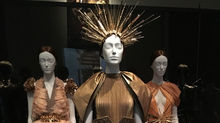Tolkien's Never-Ending Quest
"The red jumps off the page. You’re in the middle of a letter from Father Christmas to the Tolkien children, when all of a sudden, there it is—“Goblin” leaping out at you, crimson and clawed. It’s a trick Tolkien seemed to love, as another plaque in the exhibit explains that he’d wanted the inscription on the One Ring (“to rule them all …”) to be printed in red as well. We see him developing the script for those famous fiery letters, and imagine how he wanted it to blaze from the page at readers. The publishers of The Lord of the Ring didn’t go for it. The extra ink color would have been too expensive. Even the most striking item in the place, Tolkien’s beautiful mountain landscape cover for The Hobbit, had to be a little exsanguinated for publication. If you get up close to the original, you can see the texture added by the white painted over what were originally a red sun and a red dragon.
“Tolkien: Maker of Middle-Earth” is on display at the Morgan Library and Museum in Manhattan until May 12, 2019. It’s a testament to the singular achievement of Oxford professor and fantasy author J. R. R. Tolkien, but also to his failure. Tolkien took on as his life work something impossible. It wasn’t just that publishers didn’t have enough colors for him to paint his invented universe. It feels sometimes like our world didn’t.
The exhibit attracts large crowds (who are warned, on the museum’s website, that although costumes are permitted, “masks, wizard staffs, scepters, axes, bow and arrows, or swords” are not). It’s a small space with few artifacts larger than the page of a notebook—the biggest thing on display is Tolkien’s academic robe (also a still-vivid red)—so the curators have given our eyes some bigger things to rest on in the form of enlarged images of Tolkien’s watercolors covering whole walls. Thus, we can see the original of Tolkien’s piece “Eeriness” in a small glass case but also stand in front of the magnified version and imitate the Gandalfesque figure in the foreground by staring down the road limned by cool and uncanny colors as it unrolls toward the horizon.
There are two motifs in “Eeriness” that recur throughout the exhibit: surprising colors and an ever-receding horizon."






















